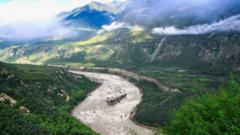The ambitious project on the Yarlung Tsangpo River could disrupt ecosystems and regional relations.
China Unveils Plans for Record-Breaking Hydropower Dam in Tibet

China Unveils Plans for Record-Breaking Hydropower Dam in Tibet
Construction of the world's largest hydropower dam raises concerns over community displacement and environmental impact
China has given the green light for the construction of the world's largest hydropower dam, located in Tibet near the Yarlung Tsangpo River. This unprecedented development has sparked apprehension over the potential displacement of local Tibetan communities and environmental consequences that may ripple through neighboring India and Bangladesh. The proposed dam is poised to produce three times the energy of the current largest hydropower facility, the Three Gorges Dam.
Chinese state-run media herald the project as a significant step toward ecological sustainability, claiming it will enhance local prosperity and aid the government's climate goals. However, human rights organizations and environmental experts are voicing strong opposition, citing fears of community displacement and severe alterations to the fragile Tibetan landscape and diverse ecosystems.
Protests against dam projects in the region have erupted in the past, drawing harsh crackdowns from Chinese authorities. For instance, earlier this year, hundreds of Tibetans protesting the Gangtuo Dam faced arrests and violence. Activists argue that the construction projects exemplify China’s ongoing exploitation of the Tibetan region, which has been under strict control since its annexation in the 1950s.
Despite claims of relocation and compensation for affected locals, activists remain skeptical, emphasizing the potential danger to sacred sites and villages anticipated to be submerged. In the case of the Yarlung Tsangpo Dam, the Chinese government has not disclosed how many people may be displaced, even as the Three Gorges Dam required the resettlement of 1.4 million individuals.
The scale of the Yarlung Tsangpo project requires the excavation of lengthy tunnels through mountainous terrain, posing significant engineering challenges due to the area's susceptibility to seismic activity. Concerns surrounding possible landslides, accentuated by the dam's grand scale and the severe geological conditions, have been raised by experts.
Additionally, the geopolitical implications are substantial, as the Yarlung Tsangpo River flows into Indian territories and then into Bangladesh. Observers speculate that control over water resources could enable China to exert considerable influence over downstream countries. Indian officials have already indicated their intention to explore large hydropower projects of their own in response to Chinese initiatives.
As the Yarlung Tsangpo construction progresses, the global community remains watchful of developments that may redefine regional dynamics and environmental integrity in one of the world's last untouched frontiers.
Chinese state-run media herald the project as a significant step toward ecological sustainability, claiming it will enhance local prosperity and aid the government's climate goals. However, human rights organizations and environmental experts are voicing strong opposition, citing fears of community displacement and severe alterations to the fragile Tibetan landscape and diverse ecosystems.
Protests against dam projects in the region have erupted in the past, drawing harsh crackdowns from Chinese authorities. For instance, earlier this year, hundreds of Tibetans protesting the Gangtuo Dam faced arrests and violence. Activists argue that the construction projects exemplify China’s ongoing exploitation of the Tibetan region, which has been under strict control since its annexation in the 1950s.
Despite claims of relocation and compensation for affected locals, activists remain skeptical, emphasizing the potential danger to sacred sites and villages anticipated to be submerged. In the case of the Yarlung Tsangpo Dam, the Chinese government has not disclosed how many people may be displaced, even as the Three Gorges Dam required the resettlement of 1.4 million individuals.
The scale of the Yarlung Tsangpo project requires the excavation of lengthy tunnels through mountainous terrain, posing significant engineering challenges due to the area's susceptibility to seismic activity. Concerns surrounding possible landslides, accentuated by the dam's grand scale and the severe geological conditions, have been raised by experts.
Additionally, the geopolitical implications are substantial, as the Yarlung Tsangpo River flows into Indian territories and then into Bangladesh. Observers speculate that control over water resources could enable China to exert considerable influence over downstream countries. Indian officials have already indicated their intention to explore large hydropower projects of their own in response to Chinese initiatives.
As the Yarlung Tsangpo construction progresses, the global community remains watchful of developments that may redefine regional dynamics and environmental integrity in one of the world's last untouched frontiers.





















